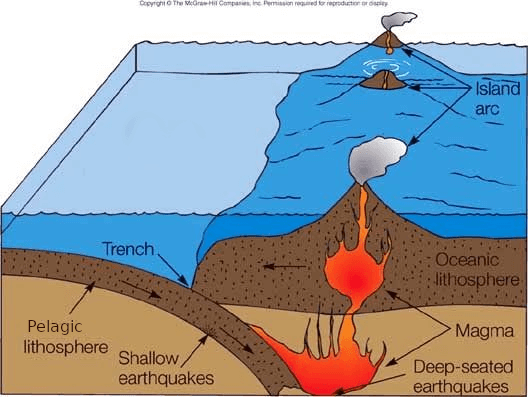Volcanoes are natural terrestrial or submarine structures, commonly hills or mountains. They are the product of magma, a molten rock buried deep into the earth that finds a way to escape to the surface. When the magma surfaces, it cools down and solidifies into lava.
Magma genesis and ascent (ref. below) to the surface of the earth is favored in highly unstable areas, in terms of tectonics. Magma escapes from the magma chamber, an area where magma is stored; it reaches the surface through volcanic conduits or feeding dykes, large cracks or intersections of cracks on the earth’s crust (active faults).
These commonly culminate to an opening called the vent. Regularly, the vent is situated in a funnel – shaped cavity called a crater. The vent and crater floor are covered by solid or fractured lava at intervals between volcanic eruptions. Then, the only evidence of volcanic activity is the emission of fumaroles i.e. hot gas and steam from ground cavities.
Volcanism is a term that refers to all manifestations linked to the ascent of magma to the earth’s surface and the occurrence of volcanic activity.
Volcanic activity may vary between two extreme types: one where magma with a low gas concentration reaches the surface generally moderately, as a continuous material stream; it then outflows from the vent generating lava flows when fluid, or lava domes when viscous. In the other type, magma with a high gas concentration causes explosions. Then, lava is ejected in fragments from the vent, and is called tephra. Tephra is also called pyroclastic matterial, while its finer fraction is called volcanic ash.
Tephra movement and depositing is mainly conducted in two ways. One is free falling from the ejection height; fallout tephra layers are deposited in this way. The other is movement of ash as a dense, fluid mixture of magma fragments and gases, flowing at a high speed and temperature on the slopes of the volcanic cone. These flows are called pyroclastic density currents, as their movement is mainly controlled by the density of the cloud; they serve to deposit the pyroclastic flows of tephra.
The vast majority of volcanoes exhibit the entire scope of volcanic activity between these two extreme types: effusion and explosion.
Depending on where the magma outflows, volcanoes are characterized as subaerial (terrestrial) if the outflow of material is in land, or as underwater (mainly submarine), if their outlet is underwater.
Aeolian Islands, characterized by continuous activity at least in the late 3-4,000 years. Most volcanoes, however, commonly exhibit short episodes lasting from a few days to a few years and then remain dormant for decades, centuries or even millennia. During this period of inactivity, the dormant volcano can be totally still or may emit gases and vapor that hint at its active state.
Volcanoes that have exhibited no activity during the ‘historic era’ were characterized as extinct in the past. In fact, as some volcanoes exhibited long periods of inactivity (even lasting several thousand years) and the term of historic records may vary depending on each site (e.g. Mediterranean – New Zealand), volcanoes exhibiting activity in the latest 10-20,000 years and which are located in active areas in terms of tectonics, thus increasing the possibility for their re – activation, are now considered to be active.
VOLCANISM AND TECTONIC ENVIRONMENT
In the 1960s, the collection of large volumes of important geophysical and geological data led to the ‘Revolution of the tectonic plate theory’, which successfully explained continental drifts and the worldwide allocation of volcanoes and earthquakes.
Lithosphere, the solid and rocky jacket of planet earth, 50-200 km thick, is fragmented into seven and as many smaller plates that ride in a state of flotation and skidding above a semi – fluid background: the asthenosphere. The basic driving force behind this movement are assumed to be the thermal convection currents, generated as the semi – plastic material of the asthenosphere, heated by the fission of radio – active elements Uranium, Thorium and Potassium, becomes lighter and ascends to the limits of the lithosphere. Subsequently, this material emits heat to the surface, cools down and thus, becoming heavier, it submerges again deep into the mantle. At areas of surfacing, where plates drift apart from each other, the hot mantle material is subject to a rapid drop in pressure, not accompanied by a proportional temperature drop.
This results in a partial melting of the mantle rock thus generating large quantities of magma. This magma ascends to the void between the two plates and builds up vast ranges of active underwater volcanoes, comprising the Mid – Oceanic Ridges. It is here that volcanoes produce the new lithosphere generating oceanic basalt crust. Such a range is the Mid – Atlantic Ridge; its formation started 200 million years ago, a product of the divergence between America and Africa – Europe.
As the Earth’s diameter is stable, the quantity of lithosphere generated must be equal to the quantity destroyed at the same time. This occurs in the areas where plates converge; there, one plate is submerged below the other along extremely deep oceanic trenches. In these areas, the subducting oceanic lithosphere carries sediment and water. Release of this water at extreme depths (100-150 kilometers) causes mantle rocks to melt, as hydrate rock melts at far lower temperatures compared to anhydrous rock.






























































































































































































































































































































































